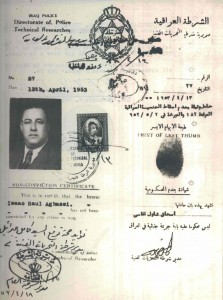 The Records of the Hebrew Immigrant Aid Society, Boston Office at the American Jewish Historical Society, New England Archives, http://digifindingaids.cjh.org/?pID=365459#a1
The Records of the Hebrew Immigrant Aid Society, Boston Office at the American Jewish Historical Society, New England Archives, http://digifindingaids.cjh.org/?pID=365459#a1
While interning at the American Jewish Historical Society—New England Archives and processing their collection of the Hebrew Immigrant Aid Society (HIAS), I came across the interesting case of the Isak Aghassi family, an Iraqi Jewish (or Mizrahi) family who for years struggled to immigrate to the United States, first from Iraq and then from Mexico. The Aghassis’ story is an extraordinary one of resolve and courage that epitomizes the struggle Iraqi Jews went through before, during, and after the period of the Second World War. Their story reveals another side of the Jewish struggle, one that is not as commonly known or understood.
Iraqi Jews are among the world’s oldest Jewish communities, dating back to the Babylonian conquest in the sixth century B.C.E. Following the establishment of the Iraqi state under the British Mandate in 1921, Jews became citizens who could vote and hold office. Before 1930, Iraqi Jews viewed themselves, and were viewed by others, as Arabs, because they had lived in the region for centuries. But as the National Socialist ideology started to spread beyond Europe, Iraqis also started to turn against their Jewish neighbors. Resentment towards the British for their colonial actions within the Middle East (and especially Iraq) also complicated the situation. By 1934, Jews had been dismissed from political posts in Iraq and violence against Jews was spreading; Zionism, the Hebrew language, and Jewish teachings became outlawed. (My own family lost a relative during this time in Iraq; my father’s uncle was hanged, suspected of “political crimes.”) Anti-British nationalist groups carried out a military coup against the pro-British government in Iraq on 2 April 1941. In this deteriorating situation, following the Second World War the Aghassi family was among those attempting to flee an inhospitable Iraq.
Isak Aghassi was born in 1889 in Baghdad and worked with his father importing dyes and teas from India, eventually focusing on carpets and tobacco. In 1946, Isak put himself, his wife Marcelle, and his two sons Badri and Jacob on a waiting list as prospective immigrants to the United States. He wrote the American Embassy in Baghdad at least once a year (receiving a yearly reply) inquiring when he and his family would be able to leave their dangerous country. The reply was always the same: the quota was over-subscribed and they would need to wait patiently. Their life in Iraq must have been treacherous and full of hardships during this period, as indicated by a letter from their HIAS file, which states that Isak Aghassi “comes from a distinguished Iraqi Jewish family. He at one time had a fortune of money which was confiscated by the Iraqi government.”
Unfortunately, Iraqi-Jews were part of the “non-preference portion” of the Iraqi quota for American immigrants, which was incredibly small; in 1956, the quota for Iraqi immigrants was 100 persons annually. In 1953, the Aghassi family emigrated to Mexico City. Helen Alpert, the HIAS executive director, sought to aid the Aghassis in their quest to immigrate to the United States and was told in 1961 that “as there is no provision of law whereby visas can be issued to intending immigrants out of their turns because of hardship factors or extenuating circumstances, I regret to inform you that there are no administrative means by which visa issuance may be hastened in this case.” Helen Alpert became close with the whole family over the years. She continually received New Year’s postcards and greetings from the Aghassis – a personal connection I haven’t seen in other HIAS files. They called her “our dearest Miss Helen Alpert” and she called them “my sister and brother.”
The Aghassi sons were allowed U.S. residency to go to school, where they excelled. Helen helped to place Badri and Jacob at American colleges, facilitated letters of recommendation for work, and made sure their visas were renewed and approved so they were able to stay in the United States to continue their studies and then find jobs.
Although it is unclear if Isak and Marcelle ever became permanent residents of the U.S., from 1963 until at least 1969 they lived in Boston with temporary resident status. One card to Helen reads “Our dearest and fine sister Miss Helen Alpert, fondest love and much respect and God bless you forever.” The parents were so thankful to Helen because she had helped their children in the most important way possible: she had been able to provide them with the means to live a safe and successful life in America instead of a dangerous and inhospitable one in Iraq.
Share this:

About Lael Dalal
Lael Dalal is completing her M.L.I.S. with a concentration in Archival Management at Simmons College. She currently works as a Graduate Fellow for Simmons College's Department of Art and Music creating websites and digitizing the slide library, and has been an intern with the American Jewish Historical Society- New England Archives since 2011. She received her B.A. from Simmons in History. Her interests include cultural heritage, history, audio and moving image archives.View all posts by Lael Dalal →